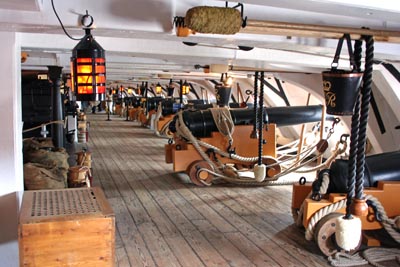
| Image Retrieved From: |
Due to the many technological constraints present during the early 1800s, naval combat of the time was f ought at extremely close ranges. Opposing lines of battle would attempt to sail parallel to one another in order to align their broadside cannon batteries with the enemy. The two columns would then pound each other until one submitted or succeeded in breaking away from the engagement. Within these contests ,changing the elevation of cannons was typically not needed for the short range and the adjustment would cost valuable time between broadsides. Adjusting the elevation was occasionally used when trying to take down an enemy ship's mast, but with the inherent inaccuracy of smooth bore cannons it was a difficult proposition. However, during combat, ships would roll on waves changing the angle at which the guns were fired, ultimately affecting the trajectory of the shot and its final destination. In combat broadsides were often fired on the up-roll in order to maximize the probability of a shot striking either the rigging or main body of the ship. The projectiles' paths may be modeled using kinematic equations.

| Image Retrieved From: |
For the purpose of
examining the motion of round shot after being fired
from a cannon the following equations will be used:
Y2 = Y1 + Vy(t) + (1/2)a(t^2) X2 = X1 +Vx(t) + (1/2)a(t^2)
Using the velocity of the round shot from the previous page and angle theta, the y position of the canonball may be determined when two dueling ships are 50 m apart. As there is no acceleration in the x direction the equation may be simplified to:
X2 = X1 + Vx(t)
If theta= 20 degrees, V = 250 m/s , and X2 = 50 m we can solve the simplified equation in the x direction in order to determine t.
t = (X2 - X1)/(Vx) => t = (50 - 0)/[ 250Cos(20) ] => t = 0.213 seconds
Using g = -9.81 m/(s^2) the second equation is complete and may be solved for Y2:
Y2 = 0 + [ 250Sin(20) ](0.213) - (1/2)(9.81)(0.213^2) => Y2 = 18 m above the initial firing position
Twenty degrees does not seem like a very large amount, but it is very evident after the calculations that even a small angle may have a major impact on a projectile's final position. This particularly highlight the difficulty of accuirately engaging a target when a ship is rolling over waves.
Y2 = Y1 + Vy(t) + (1/2)a(t^2) X2 = X1 +Vx(t) + (1/2)a(t^2)
Using the velocity of the round shot from the previous page and angle theta, the y position of the canonball may be determined when two dueling ships are 50 m apart. As there is no acceleration in the x direction the equation may be simplified to:
X2 = X1 + Vx(t)
If theta= 20 degrees, V = 250 m/s , and X2 = 50 m we can solve the simplified equation in the x direction in order to determine t.
t = (X2 - X1)/(Vx) => t = (50 - 0)/[ 250Cos(20) ] => t = 0.213 seconds
Using g = -9.81 m/(s^2) the second equation is complete and may be solved for Y2:
Y2 = 0 + [ 250Sin(20) ](0.213) - (1/2)(9.81)(0.213^2) => Y2 = 18 m above the initial firing position
Twenty degrees does not seem like a very large amount, but it is very evident after the calculations that even a small angle may have a major impact on a projectile's final position. This particularly highlight the difficulty of accuirately engaging a target when a ship is rolling over waves.